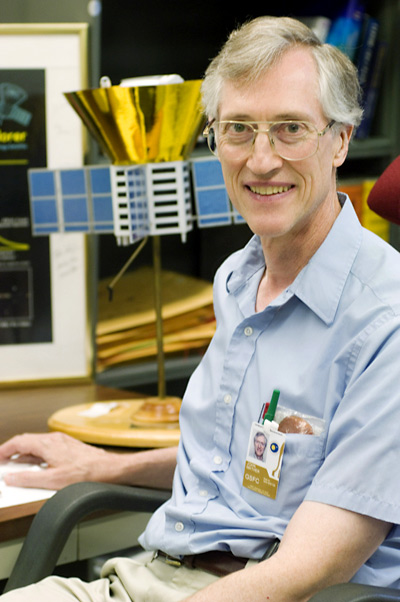Nobel laureate to examine the universe’s 14-billion-year history
A Nobel Prize-winning physicist who has spent much of his career investigating the Big Bang Theory will discuss “The History of the Universe from Beginning to End” in a public address here this week.
John C. Mather, the 2006 Nobel laureate and senior project scientist since 1995 for the James Webb Space Telescope (JWST), will deliver the physics department’s weekly colloquium at 4:10 p.m. Thursday, March 27, in Room 270 of Lewis Lab.
The JWST, a collaboration of scientists from 17 nations, is scheduled to be launched in 2018 and travel nearly 1 million miles into space to a point where it will be balanced between the gravity of the earth and the sun. With an infrared-optimized space telescope, the JWST will study the formation of stars and galaxies, the evolution of galaxies, and star and planet formation.
The Big Bang Theory, first posited in the 1920s and 1930s, holds that a cosmic explosion nearly 14 billion years ago caused the universe to expand suddenly from an extremely hot and dense state and that it has been expanding continuously since that time.
Mather’s visit comes 10 days after astronomers working at the South Pole announced that they had detected evidence corroborating the theory in the form of signals emanating from the patterns of gravity waves in microwave radiation lingering in the outer reaches of the universe.
Mather was project scientist for NASA’s Cosmic Background Explorer (COBE) satellite, which measured the spectrum of the heat radiation from the Big Bang, discovered hot and cold spots in that radiation, and hunted for the first objects that formed after the great explosion.
In his address here, he will discuss how Edwin Hubble discovered the expansion of the universe, how COBE data support the Big Bang Theory, and how the Big Bang could have produced an Earth where intelligent beings live.
Mather, who is now senior astrophysicist at NASA’s Goddard Space Flight Center in Greenbelt, Maryland, was co-recipient of the 2006 Nobel Physics Prize with American astrophysicist George Smoot. The two were honored for their work on the COBE project, which the Nobel Prize committee said could “be regarded as the starting point for cosmology as a precision science.”
Members of the COBE project discovered cosmic anisotropy (hot and cold spots in the universe’s background radiation), which are believed to be the primordial seeds that led to the structure of the universe today.
In 2007, Mather was listed among TIME magazine’s 100 most influential people in the world. In 2012, TIME named him one of the 25 most influential people in space in a special issue on space discoveries.
John C. Mather, the 2006 Nobel laureate and senior project scientist since 1995 for the James Webb Space Telescope (JWST), will deliver the physics department’s weekly colloquium at 4:10 p.m. Thursday, March 27, in Room 270 of Lewis Lab.
The JWST, a collaboration of scientists from 17 nations, is scheduled to be launched in 2018 and travel nearly 1 million miles into space to a point where it will be balanced between the gravity of the earth and the sun. With an infrared-optimized space telescope, the JWST will study the formation of stars and galaxies, the evolution of galaxies, and star and planet formation.
The Big Bang Theory, first posited in the 1920s and 1930s, holds that a cosmic explosion nearly 14 billion years ago caused the universe to expand suddenly from an extremely hot and dense state and that it has been expanding continuously since that time.
Mather’s visit comes 10 days after astronomers working at the South Pole announced that they had detected evidence corroborating the theory in the form of signals emanating from the patterns of gravity waves in microwave radiation lingering in the outer reaches of the universe.
Mather was project scientist for NASA’s Cosmic Background Explorer (COBE) satellite, which measured the spectrum of the heat radiation from the Big Bang, discovered hot and cold spots in that radiation, and hunted for the first objects that formed after the great explosion.
In his address here, he will discuss how Edwin Hubble discovered the expansion of the universe, how COBE data support the Big Bang Theory, and how the Big Bang could have produced an Earth where intelligent beings live.
Mather, who is now senior astrophysicist at NASA’s Goddard Space Flight Center in Greenbelt, Maryland, was co-recipient of the 2006 Nobel Physics Prize with American astrophysicist George Smoot. The two were honored for their work on the COBE project, which the Nobel Prize committee said could “be regarded as the starting point for cosmology as a precision science.”
Members of the COBE project discovered cosmic anisotropy (hot and cold spots in the universe’s background radiation), which are believed to be the primordial seeds that led to the structure of the universe today.
In 2007, Mather was listed among TIME magazine’s 100 most influential people in the world. In 2012, TIME named him one of the 25 most influential people in space in a special issue on space discoveries.
Posted on:
Monday, March 24, 2014


